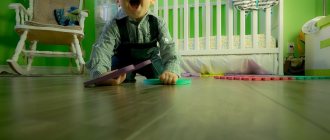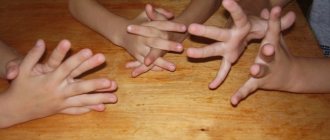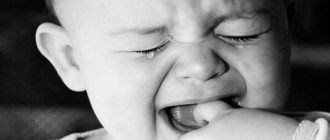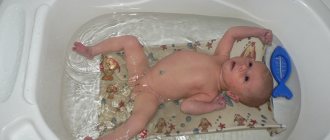After birth, the baby's development continues. He can already breathe on his own, swallow, grabs his mother’s finger, and signals by screaming if he doesn’t like something. But during the first year of life, its development still continues: the nervous system improves, the digestive tract matures. In just the first year of life, a lot of changes occur that transform the baby from a small lump into an interesting person. The development of a newborn child week by week is what every parent needs to know in order not to panic and pay attention to alarming symptoms in time.
Reflexes of newborn babies
A newborn baby has a number of innate reflexes:
- Protective. The baby turns his head to the side if he is placed on his stomach. As a rule, babies fall asleep better on their stomachs, especially during colic periods. But you need to understand that newborns have a higher chance of suffocation, and therefore you should not leave the child unattended on the tummy.
- Sucking. When the nipple enters the mouth, the baby begins to actively suckle at the breast. It is this reflex that helps the newborn receive milk from the mother's breast.
- Proboscis. When the child touches his lips, he pulls them out with a tube. This reflex is also aimed at latching onto the breast during feeding. It fades away by 2-3 months.
- Search. When the cheek is touched, the baby turns its head in the direction of the stimulus. Another reflex that is involved in breastfeeding. It will begin to fade closer to 4 months, when the baby can already see well.
- Support and walking. When the baby’s legs touch the surface, the baby rests and takes a “step.” This is an unconditioned reflex that will fade away on its own by about 6 weeks of age. It should not be used to stimulate early walking - until the musculoskeletal system is ready, such activities can cause harm.
- Crawl. When placed on the tummy, the child pushes off the surface with his arms and legs. This reflex will fade away around 4 months. It should also not be stimulated - crawling at this age does not bring benefits and can provoke disturbances in the formation of the skeleton.
- Prehensile. When placing a finger or toy in the baby's hand, he reflexively squeezes his fingers.
- Moro reflex. Sharp sounds or sudden movements of the child cause him to throw his arms to the sides, arch his back and scream.
- Babinski reflex. When you touch the foot with a finger, the fingers bend, and when passed over the entire foot, on the contrary, they unclench.
- Galant reflex. Running your hand along the spine causes the baby to arch.
The child can grab a finger or any other object that is placed in his hand
Week one, let's get acquainted
Sense organs of a newborn.
The long-awaited return home. Now the baby can get to know his mother in a calm atmosphere, see, hear, smell and touch the world around him from a new perspective, already familiar to him in absentia from the muffled sounds coming from outside during intrauterine life. A newly born child's vision is blurry; he can only distinguish large objects located nearby, which is a kind of protection against the sudden surge of variety of colors and shapes. Hearing, smell and touch are quite developed in a newborn; these sense organs developed while still alive inside the mother.
Breast-feeding
In the first week after birth, it is very important to establish breastfeeding. Get used to the fact that for the first time after birth, the baby will be in your arms almost all the time during waking moments and will constantly demand the breast.
It’s not so much a matter of hunger, but rather a need to feel the unity that is broken with the mother. Attachment to the breast at one week of age is perhaps the only and most effective way to calm a crying baby.
First bath
The first bath after birth is the most frightening procedure for new mothers and fathers. Try to do it correctly and calmly, so as not to spoil everything the first time and not cause the baby to dislike water.
Physiological characteristics of the newborn that most often cause concern:
- Regurgitation. Many mothers worry that the baby spits up often and a lot and does not eat enough. Spitting up is normal for babies up to 6 months old.
- Weight loss. In the first days after birth, breastfed babies tend to lose weight. This is normal and temporary. They will gain weight when breastfeeding is fully established.
- Jaundice. You may notice that 2-3 days after birth, the newborn’s skin tone has turned yellow. The phenomenon is also normal and is an adaptive process that results in the formation of excess bilirubin in the blood, which turns the skin yellow. If jaundice is not pathological, it goes away on its own in 7-14 days.
- Strabismus. Sometimes it may seem that a newborn's eyes are squinting. This occurs due to weakness of the eyeball muscles and inability to focus the gaze. Help your baby learn to use his eyes - hang a large, bright toy above the crib in the center, and the eyes will begin to move in sync within a few days or weeks. In very rare cases, strabismus can last up to six months, which is not yet a cause for concern.
- Trembling in sleep. Does your baby startle suddenly in his sleep? It is not at all necessary that he has problems with the nervous system. Swaddle him tightly while he sleeps to create similar living conditions during pregnancy and the baby will become calmer. Such tremors disappear on average by 3-4 months after the birth of the child.
- Peeling of the skin. After birth, the baby does not have a very attractive appearance due to a special lubricant that covers his body to facilitate the birth process and initially protect the skin from contact with air. There is no need to take it off for the first 2-3 days. Then it is absorbed and the child’s skin adapts to new conditions, resulting in peeling.
They occur due to the immaturity of the digestive tract, immaturity of the nervous system and incorrect organization of the breastfeeding process, during which air is swallowed.
For a one-week-old baby, the norm is to regurgitate after each feeding in a volume of no more than 2 tablespoons and once a day in a “fountain”. You can check the amount of milk regurgitated by pouring 2 tablespoons of water onto the diaper and comparing the stains formed from the water and milk.
Read also:
When can you baptize a newborn and how best to do it?
Do not use detergents; if the skin is dry, lubricate it, preferably with any vegetable oil, previously sterilized in a water bath. When walking, ensure that your baby is isolated from gusts of wind and direct sunlight. If you follow these recommendations, the peeling will soon go away.
7-12 weeks
From one and a half to three months, muscle tone decreases. During this period, the baby masters the following skills:
- grabs nearby toys;
- rolls over from stomach to back and back;
- holds his head confidently;
- examines objects;
- walks, “communicates” with relatives and toys.
At 2 months, the baby is already very interested in what is happening around him
. By the end of 3 months of life, colic gradually disappears. About 70% of children during this period already behave calmly in the evenings, and their tummy bothers them less and less.
Fourth trimester
The first three months of life are also called the fourth trimester of pregnancy. During this period, the baby urgently needs the constant presence of his mother, tactile, visual and verbal contact. Therefore, you should not limit your presence nearby - you need to try to take him in your arms more often, show him more new things, and help the child adapt to this world. “Hand training” is impossible in the first three months - the baby now needs the constant proximity of his mother in order to grow and develop.
Digestion
Stool occurs 2-3 times a day, it has a pasty consistency and a distinct creamy milky smell. When bottle-fed, the smell is stronger, and the color can vary from mustard to green and brown. If the child behaves normally and is not bothered by this, then there is no need to worry. If mucus or blood streaks appear, you need to contact a pediatric gastroenterologist and take a coprogram to rule out enzyme deficiency.
Growth spurt in infants up to one year old - calendar and symptoms
Week 5 - a world of changing sensations
In the first month of life, the child’s sense of the outside world was soft and similar to what it was in the womb. Now the baby begins to sense what is happening in the world around him more clearly. The baby also experiences a leap in the development of his senses. These changes have an exciting effect on him.
The baby’s nervous system has not yet fully matured, so in the evening he may be overloaded with environmental stimuli. As a result, the baby develops evening irritability caused by the accumulation of fatigue.
Try to relax your baby as much as possible in the evening and put him to bed before he becomes overtired. Remember that children at this age can stay awake for no more than 45-60 minutes.
Week 8 - the world of patterns
At 2 months, children develop sensory perception of their body. They begin to recognize simple patterns: “I have two arms,” “I can move my leg like this.”
The baby focuses his attention on objects longer than before; he is already more interested in studying the world around him. He turns towards the sounds, holds his head up and tries to push off with his arms while on his stomach. You will also notice the child's first smile.
Has your baby started crying more? Due to active physical and cognitive development, he gets tired faster, his mood changes. Tears are now the only way for the baby to tell his mother about his condition.
Create a comfortable sleeping environment to help your baby. It is necessary to darken the room, monitor the humidity and temperature in the baby’s room, and use white noise.
Week 12 - a world of soft transitions
By 3 months, the baby’s movements become softer and more precise. He begins to notice changes around him: how his mother’s voice changes when she sings, how the room becomes darker when the sun sets behind a cloud. The world becomes more organized for the baby.
By 4 months, the child’s biological rhythms are formed, the first signs of a routine appear, and sleep regression occurs. The child becomes stronger and tries to get out of the diaper. It is worth ensuring that swaddling continues to provide peace and comfort, but does not create danger. Remove the swaddle if your baby is already rolling over on his stomach while sleeping. Practice turning over while your baby is awake so that he wakes up less often during sleep.
Week 19 - world of events
During this period, the child learns to predict the sequence of events. For example, “I drop a toy, mom picks it up.” The baby gradually understands cause-and-effect relationships: if you push or grab something, then these things move.
Now is the time to introduce consistent bedtime rituals. Predictability is extremely important for children. If the mother bathes the baby in the evening and sings a certain song, he gets used to the fact that this will be followed by a crib and sleep.
Week 26 - the world of relationships
By 6.5 months, babies perceive the distance between objects or people. They try to reach objects that interest them: they roll over and begin to crawl.
Increasing mastery of one's own body and new skills lead to the appearance of anxiety and some fear in the child. The first signs of separation anxiety appear: you may notice that the baby resists going to bed, since sleep for him is the moment of separation from his mother. Let your little one know that just because you're not there doesn't mean you're not there. Play peek-a-boo, leave the room for a minute and come back with a smile on your face.
Week 37 - the world of categories
This is the age at which experiments began. Children love to try everything by touch and group them into categories of people, objects, animals and sensations.
The child checks how his actions influence the reaction of the parents: is the mother suitable to give the breast every time to help him fall asleep, or does crying at night not cause an immediate reaction and the mother only says “go to sleep, baby”? The child may begin to test boundaries, try to get what they want, which can subsequently form unwanted habits.
At 8-8.5 months, the baby stands up against a support, actively crawls and takes his first steps. During sleep, a child may get up in the crib with his eyes closed and cry, not understanding how to lie back down.
It is important to remove all unnecessary items from the crib for safety reasons. Practice new skills while your baby is awake.
Week 46 - the world of sequences
The child learns that there is an order to things in life. A certain sequence of events must occur before the desired result is achieved (the largest ring of the pyramid is down, the middle one is in the middle, the small one is up - the pyramid is assembled).
Don't neglect rituals before going to bed and after waking up. The repetition of events and their predictability gives the child peace of mind and trust in the world.
Week 55 - the world of programs
By the age of one year, the baby already understands that different sequences of events lead to the same result.
During this period, the baby begins to walk. Some parents are planning to go back to work, some mothers are stopping breastfeeding. Separation anxiety can worsen and disrupt sleep as a result of these changes.
Maintain predictable bedtime routines and remain calm when putting your baby to sleep. If you “wind down” breastfeeding, but the baby does not fall asleep without the breast, teach your baby the skill of falling asleep independently.
Development up to a year
From 3 to 12 months, the baby continues to actively develop. Norms of physical development of a child in the first year of life:
- sitting without support - 4-9 months;
- crawling - 5-12 months;
- walking with support - 6-14 months;
- independent standing - 8-17 months;
- independent walking - 9-18 months.
There is no need to rush the child’s physical development. Sitting and walking too early can have a negative impact on the musculoskeletal system in the future.
At 6 months the baby begins to sit
Intellectual development also does not stand still. By the age of one year, the child can already assemble towers from cubes, string rings onto an axle, a pointing gesture and a tweezer grip appear. Speech from humming becomes more formalized - syllables and the first simple words appear. By the age of one year, a child already clearly understands the word “impossible.”
Kids at this age really like to play with sand, water, and sort through various grains and bright beads. Such games must be under the supervision of parents so that the child does not choke on small toys or stick them in his nose or ear. The development of fine motor skills subsequently greatly helps in the development of the speech apparatus.
Child development in the first year of life
02/22/2020 Reading time: 5 min 34251 0
Caring for the health and well-being of their child is natural for all parents. But mothers and fathers experience the greatest anxiety in the 1st year after the birth of the baby. During these 12 months, the child goes through a truly enormous journey from a helpless newborn to a child who is actively exploring the world around him and knows how to interact with it.
Each stage of this path has its own characteristics, and a table of child development by month, which shows the main indicators of height and weight, will help you understand them partly.
| Age (months) | Height (cm) | Body weight (kg) |
| Newborn | 49,0 – 54,0 | 2,6 – 4,01 |
| 1 | 52,0 – 55,0 | 3,0 – 4,3 |
| 2 | 55,0 – 57,0 | 4,5 – 5,0 |
| 3 | 58,0 – 60,0 | 4,0 – 6,0 |
| 4 | 60,0 – 63,0 | 4,5 – 6,5 |
| 5 | 63,0 – 67,0 | 6,5 – 7,5 |
| 6 | 65,0 – 69,0 | 7,5 – 7,8 |
| 7 | 67,0 – 71,0 | 8,0 – 8,8 |
| 8 | 71,0 – 72,0 | 8,4 – 9,4 |
| 9 | 72,0 – 73,0 | 9,4 – 10,0 |
| 10 | 73,0 – 74,0 | 9,6 – 10,5 |
| 11 | 74,0 – 75,0 | 10,0 – 11,0 |
| 12 | 75,0 – 76,0 | 10,5 – 11,5 |
The development of a child by month, or rather the basic physical parameters of growth and weight gain given in the table, can be classified as average, since they do not take into account the individual characteristics of the baby’s body. In any case, every month of life brings new achievements for the child!
1st month
At the age of one month, the baby already tries to raise his head for a few seconds when he is in a position on his stomach. Reacts well to loud sound and bright light. In response to loud and sharp sounds or bright light, the baby “defends himself” - he waves his arms and then presses them to his body.
2nd month
By holding your baby in your arms so that his body is in an upright position, you will see that he briefly tries or is able to hold his head. The child is no longer afraid of sounds and light, but tries to smoothly follow the object of interest to him. He tries to grab moving objects that are within his reach with his fingers, although this does not always work.
3rd month
Now the baby holds his head in an upright position. And in the position on his stomach, he is already able to lean on his elbows and try to lift his upper body. He makes attempts to roll over, grab the sheet, reach for toys, but his coordination is not yet very good, and not all attempts are successful.
4th month
At this age, the baby can already push off well with his feet when you hold him vertically. Toys evoke a strong emotional response in him. Having become interested, the baby raises his head and reaches for a bright object in an attempt to grab it.
5th month
The child rolls over from his back to his stomach and attempts to rise independently to take a sitting position. But he cannot stay in it for long. But he already firmly holds in his hand the object of interest to him and carefully studies it, distinguishes close people from strangers and begins to understand his mother’s emotions by the intonations in her voice.
6th month
The baby learned not just to sit, but to sit down on his own. He easily rolls over from his stomach to his back and vice versa. Taking the child by the hands, you can observe how he is already consciously, and not reflexively, trying to walk. He reaches for a fallen toy, and if he manages to get it, he picks it up without outside help.
7th month
This is the age when it is no longer enough for a baby to sit still. He is actively mastering crawling, and, leaning on furniture or other durable objects, he can stand. The baby is increasingly interested in the world around him. He recognizes objects well (especially his favorite ones), and studying his own reflection in the mirror becomes one of the most exciting activities.
8th month
At this age, a child can play with his favorite toys for a long time. You can play “Okay” with him. He shows a wide range of emotions - from fear to joy, and when holding the hands of mom or dad, he can confidently step his feet on the floor.
9th month
Now the baby not only knows how to stand up on his own and move around, leaning on furniture, he can even refuse the help of adults and try to do everything himself. But here it is important to take into account the peculiarities of the child’s development and not rush him to take his first independent steps.
10th month
This is the age when it is no longer enough for a baby to show emotions with facial expressions. Now he can do this with the help of monosyllabic words and hand movements. He perfectly imitates everything he sees and hears: his parents’ gestures, their intonation, their activities. Can engage in simple activities for a long time: open and close a dresser drawer or cabinet door, throw and pick up a toy, etc.
11th month
Communication skills have developed to the extent that the baby can express his agreement and disagreement, approval and disapproval with the correct gestures and facial expressions. Refusing something, he shakes his head and nods in agreement. He already knows what sounds animals make, and when asked to show something or do something, he usually readily agrees.
12th month
The child is interested in absolutely everything that happens around him: the noise of traffic outside the window, the movement of water while swimming, more complex toys. He knows how to perform difficult tasks expressed in words: upon request, he closes or opens the door, brings the necessary items from another room.
All babies are different, and if some of the skills described appear a little earlier or a little later, don’t worry or be upset! You can always ask your pediatrician about all the developmental features of your child.
(7 ratings; article rating 4.9)
Share Share Share
Seventh month
By this time, the child has learned to understand the meaning of many words and points his finger at objects of interest. He understands that the trick with missing things is just a trick, and they can be found.
Many toddlers begin to experience fear when parting with their mother, which is a high indicator of mental development.
Skills and abilities:
- the child stands up with the help of support and moves while standing;
- crawls confidently, but it also happens that the baby skips the crawling period and immediately begins to move, holding onto support.
| Children | Weight, kg | Height, cm | ||||
| min. | average | max. | min. | average | max. | |
| Girls | 5,3 | 7,6 | 11,1 | 60,3 | 67,3 | 74,2 |
| Boys | 5,9 | 8,3 | 11,4 | 62,7 | 69,2 | 75,7 |
Read also:
Recommendations of Dr. Komarovsky for intestinal colic in infants
Week two, getting used to it
A week has passed. For a newborn, this is a huge period of time, including a lot of new impressions, getting to know his body and the world around him. The umbilical wound is healing. The baby completely adapts to the new way of getting food. The number of intestinal bowel movements is normalized and is 3-4 times a day.
Weight gain begins. The baby becomes more and more interested in what is happening around him and begins to listen to surrounding sounds and look at objects more carefully. He can examine all the details from a distance of 20-25 cm. At this time, facial expressions begin to develop - your pet may even please you with his first smile.
Now your happiness can be overshadowed by the onset of intestinal colic, accompanied by prolonged crying and squeezing, twisting of the legs. You can start fighting them, but there is no consensus among doctors about both the cause of their occurrence and ways to alleviate the condition. There is only one piece of advice: be patient, sooner or later they will stop.
Table No. 1 “Weight norm for a newborn one month old baby”
| Weight, kg | Below the average | Average | Above average |
| Girls | 3,3–3,6 | 3,8–4,5 | 4,7–5,1 |
| Boys | 3,3–3,6 | 4,0–4,7 | 5,1–5,4 |
However, the main thing is not how much a child should weigh per month, but how much he has gained during this period. A baby must gain 600 grams in the first month. This is the acceptable minimum. The increase can be 800 grams or a kilogram. The main thing is that it is not less than the norm.
For example, a boy was born weighing 4.5 kilograms. At 1 month he weighs 4700. It would seem that this is a completely normal average (see table). But the increase was only 200 grams. This will definitely alert the doctor.
The reason for the small increase may be improperly organized feeding. Perhaps the baby is not getting enough nutrition. If the baby is breastfed, a control weighing is prescribed before and after feeding to find out how much the baby sucks. The mother needs to stimulate additional milk production, and in some cases additional feeding is introduced with a specially adapted milk formula.
When bottle-feeding, you need to work with your doctor to adjust the amount of formula, and sometimes change it to another.
Milk or its substitute is the main and only food for a newborn. But it happens that it is poorly absorbed, and this becomes another reason for weight loss. The baby does not have enough or no lactase enzyme to digest milk. If lactase deficiency is suspected, the doctor will prescribe tests, and based on their results, treatment that will help regulate nutrition and weight gain.
The baby's height should also increase by the age of one month. The body length with which a baby is born largely depends on hereditary factors. A petite mom and a short dad are unlikely to have a large baby. But then normal growth is again determined by the quality of nutrition. Over the course of 1 month of life, a baby grows in length by an average of 3 centimeters.
Second month
The period is characterized by the establishment of a similar pattern of sleep and wakefulness. The baby still sleeps a lot, but now mom knows when and approximately how much time he needs to rest. Now he can firmly grasp everything that falls into his hands.
What a baby should be able to do:
- focus your gaze not only on moving, but also on stationary objects;
- roll over from side to side;
- briefly hold the head from a position lying on your tummy, try to rise on your arms, arching your back, turn your head towards the sound;
- demonstrate the support reflex: feel the support under your legs and push off from it;
- demonstrate a “revival complex” when adults appear: smile, move arms and legs, arch, “walk”, making drawn-out vowel sounds.
| Children | Weight, kg | Height, cm | ||||
| min. | average | max. | min. | average | max. | |
| Girls | 3,4 | 5,1 | 7,5 | 51 | 57,1 | 63,2 |
| Boys | 3,8 | 5,6 | 8 | 52,4 | 58,4 | 64,4 |
Read also:
Why may a newborn not poop for several days?
Preschool age stage of development in a child
This stage begins at the age of 3 and ends when the child enters school. During this period, the personal qualities of the child’s character initially begin to be laid down, and personal mechanisms of behavior develop. A child strives to be like his parents, so example is very important here. If you teach your baby not to scream, but you yell at him yourself, then your baby will not learn anything. He will only copy you. Speech and communication with peers are actively developing.
During this period, the child actively develops all mental processes: memory, attention, thinking, imagination, etc. The child prepares for school, learns to take responsibility
Children of this age are able to draw logical conclusions from their observations.
At the age of 6, children experience a crisis. The child begins to grow quickly, body proportions change, permanent teeth appear, and behavior changes dramatically. In children, a demonstrative form of behavior predominates. The mood changes hourly, the child grimaces and behaves.
A child of this age should be able to and know:
- geometric figures;
- master the concepts of size, length, height;
- compare objects by shape and color;
- compare numbers;
- mathematical signs and letters;
- count forward and backward;
- find extra items among items of the same type;
- compose a story using pictures, following the sequence;
- conduct dialogue and monologue.
Eleventh month
Skills of the 9th and 10th months of life develop, such as speech and communication, walking with support, coordination of movements, hand motor skills, speech, and attempts to take independent steps are improved.
| Children | Weight, kg | Height, cm | ||||
| min. | average | max. | min. | average | max. | |
| Girls | 6,1 | 8,7 | 12,8 | 65,2 | 72,8 | 80,3 |
| Boys | 6,8 | 9,4 | 13 | 67,6 | 74,5 | 81,5 |
Twelfth month, summing up
What the child has achieved by the 12th month of life:
- Most children walk without support, speak a poorly understood dialect, eat independently with a spoon and drink from a cup or sippy cup.
- They do not like to be left alone; they need constant attention and communication with adults.
- They can play with toys independently within a few minutes.
- They know the names of almost all surrounding objects and try to pronounce them.
- Examine the contents of cabinets and drawers.
- They love to watch animals, which causes indescribable delight.
| Children | Weight, kg | Height, cm | ||||
| min. | average | max. | min. | average | max. | |
| Girls | 6,3 | 8,9 | 13,1 | 66,3 | 74 | 81,7 |
| Boys | 6,9 | 9,6 | 13,3 | 68,66 | 75,7 | 82,9 |
A year has passed, the child has passed the path of becoming from a tiny incompetent person into a human person with his own individual character, a baggage of acquired knowledge and skills. Many babies at this age begin to walk independently. Upright walking is an epoch-making turn in the development of an infant. A completely different world opens up for the little man, different from the one he previously knew, limited by the scope of his ability to move. A world of discovery and knowledge.










